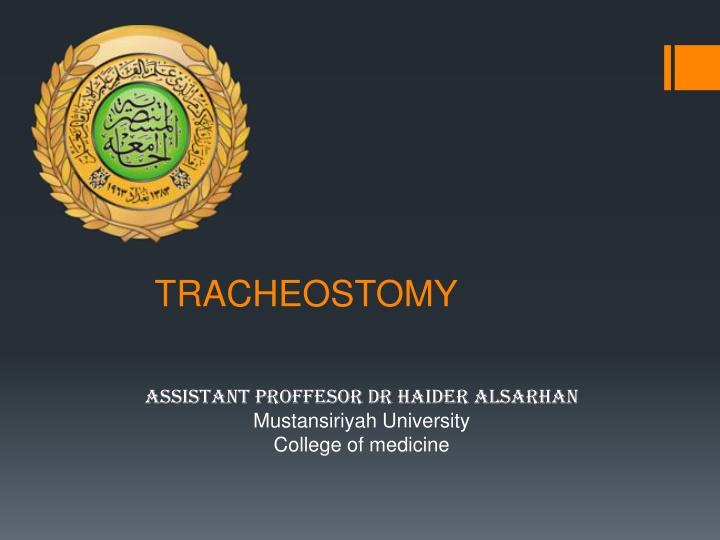
Tracheostomy: Indications, Procedure, and Advantages
Explore the world of tracheostomy, an artificial airway creation procedure, including its indications, contraindications, advantages, and the surgical process involved. Learn about the benefits of tracheostomy for patients with specific medical conditions. Discover the importance of this procedure in providing airway support and improving patient outcomes.
Download Presentation

Please find below an Image/Link to download the presentation.
The content on the website is provided AS IS for your information and personal use only. It may not be sold, licensed, or shared on other websites without obtaining consent from the author. If you encounter any issues during the download, it is possible that the publisher has removed the file from their server.
You are allowed to download the files provided on this website for personal or commercial use, subject to the condition that they are used lawfully. All files are the property of their respective owners.
The content on the website is provided AS IS for your information and personal use only. It may not be sold, licensed, or shared on other websites without obtaining consent from the author.
E N D
Presentation Transcript
TRACHEOSTOMY assistant Proffesor Dr Haider Alsarhan Mustansiriyah University College of medicine
What is a Tracheostomy? A tracheostomy is a artificial (usually) surgically created airway fashioned by making a hole in the anterior wall of the trachea and the insertion of a tracheostomy tube, which may or may not be permanent
Indications Upper Airway obstruction secondary to trauma, burns corrosive poisoning, laryngeal dysfunction, foreign body, infections, inflammatory conditions, neoplasms, Postoperatively , obstructive sleep apnea Access for pulmonary toilet Prolonged ventilatory support Airway protection in head injured or comatose patient and in postoperative neurosurgical patients
Contraindications Relative 1. Unstable cervical spine 2. Uncorrected coagulopathy 3. Presence of neck mass or pervious neck surgery 4. History of mediastinal irradiation due to intrathoracic fibrosis 5. Previous history of surgical tracheostomy
Advantages of Tracheotomy Increased patient mobility More secure airway Increased comfort Improved airway suctioning Early transfer of ventilator-dependent patients from the intensive care unit (ICU) Less endo-laryngeal injury Enhanced oral nutrition Enhanced phonation and communication Decreased airway resistance for promoting weaning from mechanical ventilation Decreased risk for nosocomial pneumonia
Surgical Tracheostomy Surgical tracheostomy (ST) is usually performed in the operating room on a patient under general anesthesia, but it may be performed at the bedside in the intensive care unit. The patient s shoulders are elevated with head extension (unless cervical disease or injury is present), elevating the larynx and exposing more of the upper trachea. Local anesthesia with a vasoconstrictor is usually infiltrated into the skin and deeper tissues
Procedure The skin of the neck over the 2nd tracheal ring is identified, and a vertical incision about 2 3 cm in length is created. Sharp dissection following the skin incision is used to cut across the platysma muscle, and bleeding controlled by hemostats and ties or electocautery.
Blunt dissection parallel to the long axis of the trachea is then used to spread the submuscular tissues until the thyroid isthmus is identified If the gland lies superior to the 3rd tracheal ring, it can be bluntly undermined and retracted superiorly to gain access to the trachea
There are 2 basic approaches to tracheal entry. the 2nd tracheal ring is divided laterally and the anterior portion removed. Lateral sutures are used to provide counter traction during tracheostomy-tube insertion. These are left uncut to provide assistance if the tube is accidentally dislodged later. trac4
Tracheostomy Tubes Tracheostomy tubes are available in a variety of sizes and styles, from several manufacturers. Dimensions of tracheostomy tubes are given by their inner diameter (ID), outer diameter (OD), length, and curvature. Tracheostomy tubes can be angled or curved, a feature that can be used to improve the fit of the tube in the trachea. Cuffs on tracheostomy tubes include high-volume low-pressure cuffs, tight-to shaft cuffs, and foam cuffs. Tracheostomy tubes which have an inner cannula are called dual cannula tracheostomy tubes.
Metal versus Plastic tracheostomy tubes Tracheostomy tubes can be of either metal or plastic. Metal tubes are constructed of silver or stainless steel. Metal tubes are not used commonly because they are expenseive, rigid construction uncuffed lack a 15 mm connector for attachment to a ventillator
Plastic tubes are most commonly used and are made from polyvinyl chloride or silicone. Polyvinyl chloride softens at body temperature (thermolabile), conforming to patient s tracheal anatomy and centering the distal tip in the trachea
Cuffed Tracheostomy tube Cuffed tracheostomy tubes allow airway clearance, protection from aspiration positive pressure ventilation It is recommended that cuff pressure be maintained at 20 25 mmHg to minimize the risks for both tracheal wall injury and aspiration.
Fenestrated tracheostomy tubes The fenestrated tracheostomy tube is similar in construction to standard tracheostomy tubes, with the addition of an opening in the posterior portion of the tube above the cuff. With the inner cannula removed, the cuff deflated, and the tracheostomy air passage occluded, the patient can inhale and exhale through the fenestration and around the tube.
This allows for assessment of the patients ability to breathe through the normal oral/nasal route preparing the patient for decannulation allowing phonation Supplemental oxygen administration to the upper airway (eg, nasal cannula) may be necessary if the tube is capped.
EARLY COMPLICATIONS Early bleeding: This is usually the result of increased blood pressure as the patient emerges from anesthesia and begins to cough. Plugging with mucus Tracheitis Cellulitis Tube displacement Subcutaneous emphysema Atelectasis
LATE COMPLICATIONS Bleeding - Due to tracheoinnominate fistula 0.4% with mortality rate of 85% to 90%. Major airway hemorrhage may occur within first several days or as long as 7 months after performance of a tracheostomy. Risk factors : excessive tube movement, low placement of the tracheostomy, sepsis, poor nutritional status, and corticosteroid therapy Tracheo- and laryngomalatia Stenosis Itcan develop from 1 to 6 months after decannulation risk for tracheal stenosis ranges between 0% and 16%
Tracheoesophageal fistula fewer than 1% of patients as a result of pressure necrosis of the tracheal and esophageal mucosa from the tube cuff Risk factors : high cuff pressures, presence of a nasogastric tube, excessive tube movement, and underlying diabetes mellitus Tracheocutaneous fistula Granulation Scarring Failure to decannulate
Tracheotomy care Humidification Tube position To prevent decubitus of trachea Suctioning Skin care To prevent irritation and secondary inflammation due to discharge Inner tube care frequent remove and clean crusts
Speech with tracheotomy Spontaneous breathers Tolerate cuffless mech. ventilation Conscious patient For mechanically dependent patients that may tolerate cuff deflation For unable to close the tube outlet with finger (quadriplegia) (Passy-Muir valves)
A tracheostomy speaking valve is a one-way valve, allows air in, but not out This forces air around the tracheostomy tube, through the vocal cords and the mouth upon expiration, enabling the patient to vocalize
Advantages of metallic tubes 1. can not be kinked 2. maintain lumen 3. easier insertion during surgery 4. shown by X Ray










